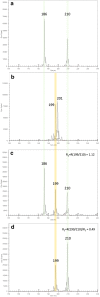Male and female inheritance patterns in tetraploid 'Moncada' mandarin
- PMID: 31781856
- PMCID: PMC7018676
- DOI: 10.1007/s00299-019-02494-y
Male and female inheritance patterns in tetraploid 'Moncada' mandarin
Abstract
Tetraploid `Moncada´ mandarin, used as male and female in interploidy hybridizations, displays mainly tetrasomic inheritance for most LGs, with slight variations according to the direction of the crossing. Triploid-breeding programs in citrus are key tool to develop seedless cultivars. Obtaining triploid citrus hybrids may be achieved through different strategies, such as the exploitation of female unreduced gamete in crosses between diploid parents and diploid by tetraploid sexual hybridizations, in which tetraploid genotypes can be used as male or female parents. Genetic configuration of triploid populations from interploid crosses greatly depends on the chromosomic segregation mode of the tetraploid parent used. Here, we have analyzed the inheritance of the tetraploid 'Moncada' mandarin and compared the genetic structures of the resulting gametes when used as male and as female parent. The preferential chromosome pairing rate is calculated from the parental heterozygosity restitution (PHR) of codominant molecular markers, indicating the proportion between disomic and tetrasomic segregation. Tetraploid 'Moncada' both as female and male parent largely exhibited tetrasomic segregation. However, as female parent, one linkage group (LG8) showed intermediate segregation with tendency towards tetrasomic inheritance, while another linkage group (LG4) evidenced a clear intermediate segregation. On the other hand, when used as male parent two linkage groups (LG5 and LG6) showed values that fit an intermediate inheritance model with tetrasomic tendency. Significant doubled reduction (DR) rates were observed in five linkage groups as female parent, and in six linkage groups as male parent. The new knowledge generated here will serve to define crossing strategies in citrus improvement programs to efficiently obtain new varieties of interest in the global fresh consumption market.
Keywords: Citrus; Disomic inheritance; SSR and SNP markers; Tetraploid; Tetrasomic inheritance; Triploid.
Conflict of interest statement
The authors declare that the research was conducted in the absence of any commercial or financial relationships that could be construed as a potential conflict of interest.
Figures




Similar articles
-
Inheritance in doubled-diploid clementine and comparative study with SDR unreduced gametes of diploid clementine.Plant Cell Rep. 2016 Aug;35(8):1573-86. doi: 10.1007/s00299-016-1972-4. Epub 2016 Apr 2. Plant Cell Rep. 2016. PMID: 27038940
-
Evidence for non-disomic inheritance in a Citrus interspecific tetraploid somatic hybrid between C. reticulata and C. limon using SSR markers and cytogenetic analysis.Plant Cell Rep. 2011 Aug;30(8):1415-25. doi: 10.1007/s00299-011-1050-x. Epub 2011 Mar 16. Plant Cell Rep. 2011. PMID: 21409551
-
Inheritance pattern of tetraploids pummelo, mandarin, and their interspecific hybrid sour orange is highly influenced by their phylogenomic structure.Front Plant Sci. 2023 Dec 8;14:1327872. doi: 10.3389/fpls.2023.1327872. eCollection 2023. Front Plant Sci. 2023. PMID: 38143579 Free PMC article.
-
Origin of C. latifolia and C. aurantiifolia triploid limes: the preferential disomic inheritance of doubled-diploid 'Mexican' lime is consistent with an interploid hybridization hypothesis.Ann Bot. 2018 Mar 5;121(3):571-585. doi: 10.1093/aob/mcx179. Ann Bot. 2018. PMID: 29293884 Free PMC article.
-
Distant hybridization leads to different ploidy fishes.Sci China Life Sci. 2010 Apr;53(4):416-25. doi: 10.1007/s11427-010-0057-9. Epub 2010 May 7. Sci China Life Sci. 2010. PMID: 20596907 Review.
Cited by
-
Meiotic Behaviors of Allotetraploid Citrus Drive the Interspecific Recombination Landscape, the Genetic Structures, and Traits Inheritance in Tetrazyg Progenies Aiming to Select New Rootstocks.Plants (Basel). 2023 Apr 12;12(8):1630. doi: 10.3390/plants12081630. Plants (Basel). 2023. PMID: 37111854 Free PMC article.
-
Analysis of Crossover Events and Allele Segregation Distortion in Interspecific Citrus Hybrids by Single Pollen Genotyping.Front Plant Sci. 2020 May 25;11:615. doi: 10.3389/fpls.2020.00615. eCollection 2020. Front Plant Sci. 2020. PMID: 32523591 Free PMC article.
-
Pollen Development and Viability in Diploid and Doubled Diploid Citrus Species.Front Plant Sci. 2022 Apr 25;13:862813. doi: 10.3389/fpls.2022.862813. eCollection 2022. Front Plant Sci. 2022. PMID: 35557738 Free PMC article.
-
Genotyping of polyploid plants using quantitative PCR: application in the breeding of white-fleshed triploid loquats (Eriobotrya japonica).Plant Methods. 2021 Sep 3;17(1):93. doi: 10.1186/s13007-021-00792-9. Plant Methods. 2021. PMID: 34479588 Free PMC article.
References
-
- Ahmad R, Struss D, Southwick SM. Development and characterization of microsatellite markers in citrus. J Am Soc Hortic Sci. 2003;128:584–590. doi: 10.21273/jashs.128.4.0584. - DOI
MeSH terms
Substances
Grants and funding
LinkOut - more resources
Full Text Sources

